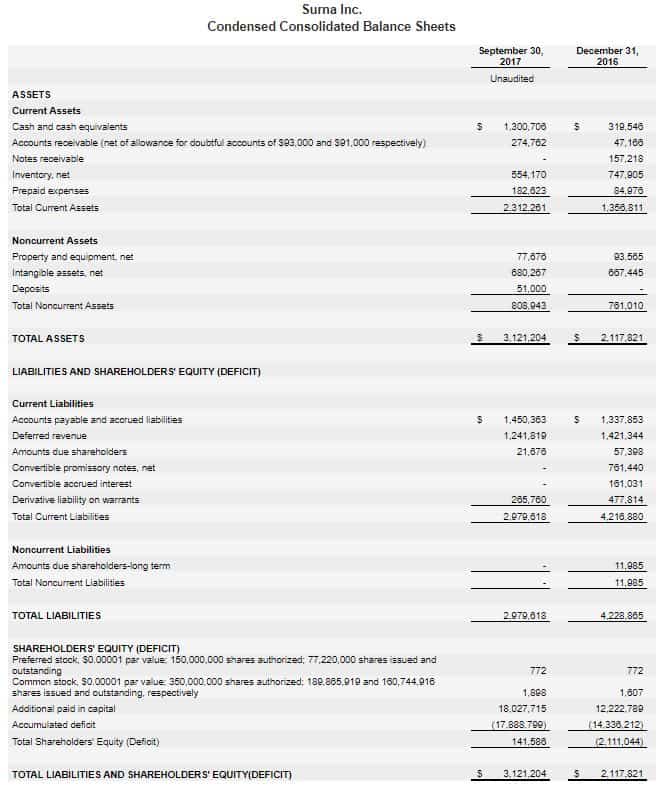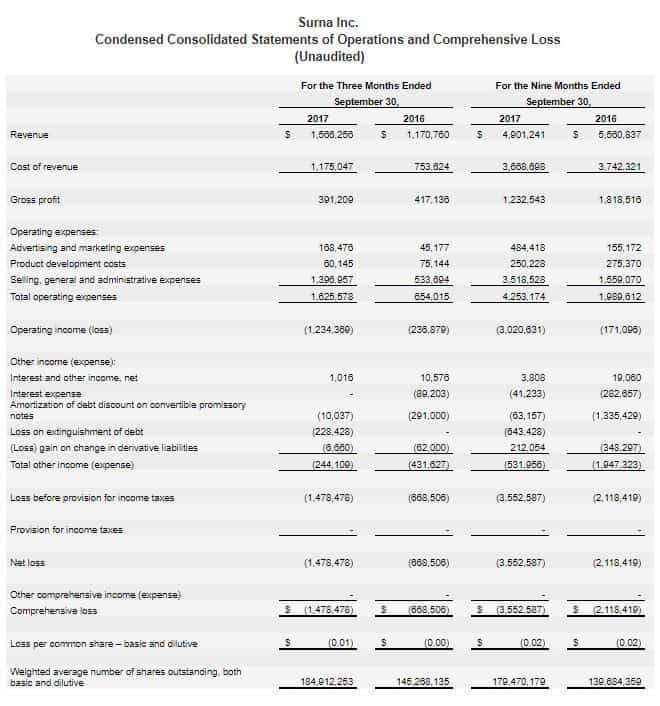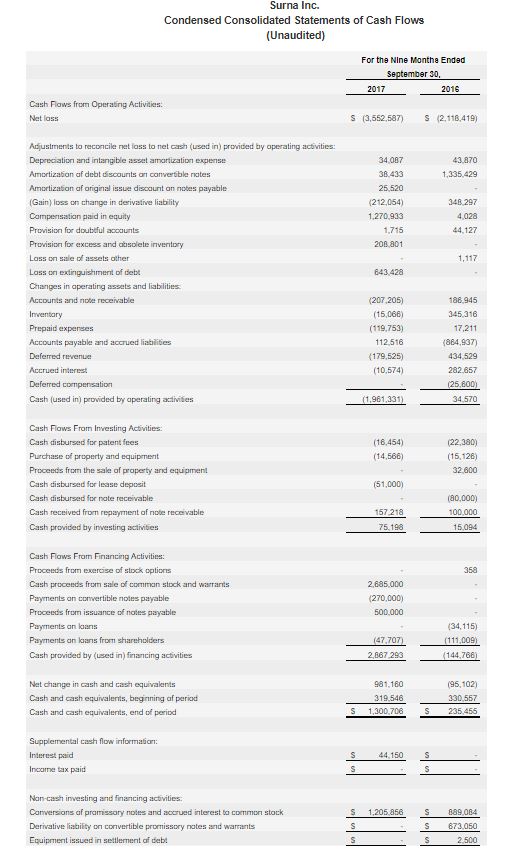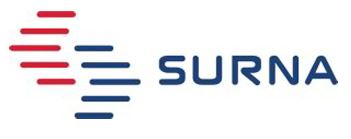
Surna Reports Q3 2017 Results
BOULDER, Colorado, Nov. 14, 2017 /PRNewswire/ — Surna Inc., a manufacturer of a proprietary line of application-specific lighting, environmental control and air sanitation systems for state-regulated cannabis cultivation facilities as well as traditional indoor agricultural facilities (OTCQB: SRNA), announced today operating and financial results for the three and nine months ended September 30, 2017. They will not be hosting a conference call following the release of our financial results.
Highlights
- Our revenue for the three months ended September 30, 2017 was $1,566,000 an increase of $395,000, or 34%, compared to the three months ended September 30, 2016.
- During the three months ended September 30, 2017, we were awarded new sales contracts totaling $2,385,000, bringing our total new sales contracts awarded for the nine months ended September 30, 2017 to $7,182,000.
- As of September 30, 2017, the unearned contract value of our outstanding sales contracts for which we have received an initial cash deposit increased to $4,311,000 (“Q3 2017 backlog”).
- We realized an operating loss of $1,234,000 for the three months ended September 30, 2017 which includes $626,000 of non-cash, equity-based compensation expenses.
- As of September 30, 2017, our cash balance was $1,301,000, a decrease of 3.9% from our cash balance of $1,353,000 as of June 30, 2017.
Overall, we are pleased with the progress our team has made in the third quarter, particularly with the generation of almost $2.4 million in new sales contracts. Based on the current status of our projects, we are tracking toward the completion of more than half of our current backlog by year’s end.
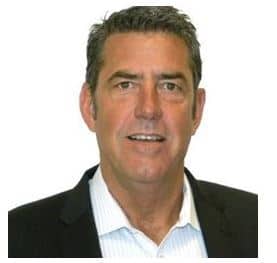 Chris Bechtel, Surna’s CEO
Chris Bechtel, Surna’s CEO
Despite our third quarter operating loss, our cash balance decreased less than 4%, ending at $1,301,000, with our balance sheet remaining free of any long-term debt.
Results of Operations
Revenue for the three months ended September 30, 2017 was $1,566,000 compared to $1,171,000 for the three months ended September 30, 2016, an increase of $395,000, or 34%.
Cost of revenue increased by 56% from $754,000 for the three months ended September 30, 2016 to $1,175,000 for the three months ended September 30, 2017.
The gross profit for the three months ended September 30, 2017 was $391,000 compared to $417,000 for the three months ended September 30, 2016. Gross profit margin decreased by 11 percentage points from 36% for the three months ended September 30, 2016 to 25% for the three months ended September 30, 2017. This decrease was caused by an unfavorable sales mix of lower margin products (i.e., equipment manufactured by outside vendors) and increased manufacturing overhead compared to the three months ended September 30, 2016.
We sell an integrated solution that can create gross profit margin fluctuations depending on the project design and the mix between our proprietary equipment, which typically generates a higher gross profit margin, and the equipment manufactured by outside vendors, which has a lower gross profit margin.
Operating expenses increased by 148% from $654,000 for the three months ended September 30, 2016 to $1,625,000 for the three months ended September 30, 2017, an increase of $971,000. The operating expense increase consisted of: (i) an increase in selling, general and administrative expenses (“SG&A expenses”) of $862,000, and (ii) an increase in advertising and marketing of $123,000, offset by (iii) a decrease in product development expense of $15,000.
The increase in SG&A expenses for the three months ended September 30, 2017 compared to the three months ended September 30, 2016 is due primarily to: (i) an increase of $452,000 in equity-related employee compensation, (ii) an increase of $220,000 in salaries and benefits, (iii) an increase of $115,000 in legal and consulting fees, and (iv) an increase of $113,000 in cash and equity-based director fees.
The increase in marketing expenses have been primarily a result of: (i) our investment in re-branding the Surna name, including approximately $55,000 for the redevelopment of our website and marketing materials, (ii) our increased presence at industry trade shows and events, resulting in increased expenses of $25,000, and (iii) marketing salaries and benefits (including equity-related compensation), which increased by $24,000.
We realized an operating loss of $1,234,000 for the three months ended September 30, 2017 as compared to an operating loss of $237,000 for the three months ended September 30, 2016. However, we incurred $626,000 of non-cash, equity-based compensation expenses in the three months ended September 30, 2017 as compared to $0 for the three months ended September 30, 2016. Excluding these non-cash items, our operating loss increased by $371,000.
Overall, we realized a net loss of $1,478,000 for the three months ended September 30, 2017 as compared to a net loss of $669,000 for the three months ended September 30, 2016, an increase of $809,000. However, we incurred $626,000 of non-cash, equity-based compensation expenses and $245,000 of non-cash, debt-related costs in the three months ended September 30, 2017 as compared to non-cash, debt-related costs of $353,000 in the three months ended September 30, 2016. Excluding these non-cash items, our net loss increased by $291,000.
Regulatory Changes are Leading Indicator for New Facility Construction
The demand for our products and services is primarily based on the new construction of cannabis cultivation facilities in the U.S. and Canada. Due to the continued uncertainty of the cannabis industry following the U.S. Justice Department’s announcement of its opposition to legalized cannabis in early 2017, we believe there may be some delay in new cannabis cultivation facility projects by potential customers.
Recent and anticipated regulatory changes involving medicinal and/or recreational cannabis use in various jurisdictions, such as California, tends to be a leading indicator for the granting of licenses for new facility construction. As more new cultivation facilities become licensed, we have an expanded set of opportunities and customers to whom we can potentially sell our systems.
For 2017, our sales efforts have been focused on: (i) new facility construction in California, where recreational cannabis use was approved in November 2016, and (ii) in Canada, where medicinal use is federally legal, and the federal government has signaled its intention to legalize recreational adult use in 2018.
During the third quarter of 2017, we began implementing a two-tiered sales model. The first tier involves direct sales efforts in various regions across the U.S. and Canada. We currently have three employees assigned to direct sales and one employee assigned to inside sales. The second tier involves utilization of our two technical advisors and their expertise to complement the direct sales efforts. In furtherance of this new model, our previous Chief Executive Officer shifted his focus to developing the California market (including his physical relocation in the state), and he now serves as our Vice President of Business Development – West Coast. We expect his industry experience, combined with his knowledge of our business, to help us capture market share in the largest growth area in the U.S. We have also hired, or intend to hire, additional direct sales personnel for the East Coast, Pacific Northwest and other North American markets.
Sales Contract Backlog
Our Q3 2017 backlog of $4,311,000 consists of (i) $1,972,000 attributable to sales contracts executed during the three months ended September 30, 2017, and (ii) the remaining $2,339,000 attributable to prior quarters. About 45% of our Q3 2017 backlog (up from 30% in Q2 2017) is attributable to projects for which we have not received a further deposit on our proprietary equipment and, as a result, there are potential risks of project cancellation or delays.
The increase in backlog is attributable to new contracts awarded in the third quarter of 2017 totaling $2,385,000, bringing our total new sales contracts awarded for the nine months ended September 30, 2017 to $7,182,000. However, based on the current status of our outstanding sales contract, we believe at least 50% of our Q3 2017 backlog could be recognized as revenue in Q4 2017.
In an effort to increase our bookings of new sales contracts and grow our revenue, we are: (i) in the process of upgrading our lead generation and business development system, (ii) overhauling our project management processes, (iii) continuing to build our direct sales team with more experienced personnel, (iv) reallocating sales territories to allow the sales personnel to focus on individual regional needs and to become more personally involved in their markets, and (v) implementing improved management information systems to increase sales pipeline visibility and the associated accountability for each of our direct sales people.
Nonetheless, the ever-changing nature of our sales and the needs of our customers make it difficult for us to predict when we will recognize revenue. We continue to remain focused on increasing our sales contract backlog and quoting larger projects in an effort to increase revenue.
Balance Sheet and Capital Requirements
We had a deficit in working capital (current liabilities in excess of current assets) of $667,000 as of September 30, 2017 as compared to a working capital deficit of $2,860,000 as of December 31, 2016. This improvement in working capital during the nine months ended September 30, 2017 is primarily related to: (i) the $2,685,000 raised in a private placement of our common stock and attached warrants, (ii) the conversion to common stock of the convertible promissory notes and related interest payable, and (iii) the conversion of certain other notes.
As of September 30, 2017, our cash balance was $1,301,000, a decrease of 3.9% from our cash balance of $1,353,000 as of June 30, 2017. However, to date, we have not been able to generate sufficient cash from operating activities to fund our ongoing operations. Cash used in operations for the nine months ended September 30, 2017 was $1,961,000, compared to cash generated from operations of $35,000 for the nine months ended September 30, 2016. The increase in cash used is primarily attributable to an increase in net loss of $1,434,000, which was offset by an increase in non-cash charges of $234,000, and additional cash used for working capital of $796,000.
Since our inception, we have raised capital through private sales of common stock and debt securities. Our future success is dependent upon our ability to achieve profitable operations and generate cash from operating activities, including our receipt of deposits from customers under our sales contracts.
Management has determined that we will likely need to raise debt and/or equity financing during the first half of 2018 in order to continue our operations and achieve our growth targets. However, there can be no assurance that we will be able to raise such financing in sufficient amounts or on acceptable terms, or at all.
If, as we move into the first half of 2018, we determine that our revenue and operating results are not satisfactory, we intend to explore various operating cost reductions. Even if we were able to reduce operating costs, we would still likely need to seek additional debt and/or equity financing. The precise amount and timing of the funding needs will depend on a number of factors, including the market demand for our products and services, the timing of our receipt of deposits from our customers under our sales contracts, our management of working capital, and the continuation of normal payment terms and conditions for purchase of goods and services.
About Surna, Inc.
Surna Inc. (www.surna.com) develops innovative technologies and products that monitor, control and or address the energy and resource intensive nature of indoor cannabis cultivation. Currently, our revenue stream is derived primarily from supplying industrial technology and products to commercial indoor cannabis grow facilities.
Headquartered in Boulder, Colorado, our engineering team strives to create novel energy and resource efficient solutions, including our signature water-cooled climate control platform to create technological solutions and products that solve the highly specific demands of the cannabis industry for temperature, humidity, light and process control. Our goal is to provide intelligent solutions to improve the quality, the control and the overall yield and efficiency of controlled environment agriculture. Though our customers do, we neither produce nor sell cannabis.
Statement about Cannabis Markets
The use, possession, cultivation, and distribution of cannabis is prohibited by federal law. This includes medical and recreational cannabis. Although certain states have legalized medical and recreational cannabis, companies and individuals involved in the sector are still at risk of being prosecuted by federal authorities. Further, the landscape in the cannabis industry changes rapidly. What was the law last week is not the law today and what is the law today may not be the law next week. This means that at any time the city, county, or state where cannabis is permitted can change the current laws and/or the federal government can supersede those laws and take prosecutorial action. Given the uncertain legal nature of the cannabis industry, it is imperative that investors understand that the cannabis industry is a high-risk investment. A change in the current laws or enforcement policy can negatively affect the status and operation of our business, require additional fees, stricter operational guidelines and unanticipated shut-downs.
